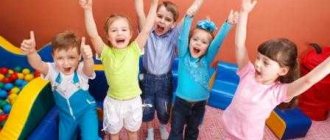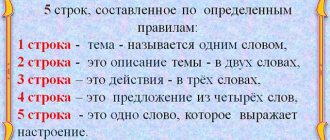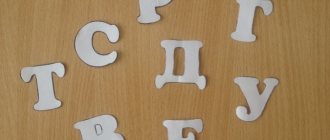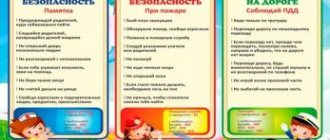MAGAZINE Preschooler.RF
Non-traditional forms of working with children in the organization of educational activities, aimed at the implementation of the Federal State Educational Standards for preschool educationPedagogical article
Author: Irina Viktorovna Nazarenko, Municipal Budgetary Preschool Educational Institution No. 7 “Rainbow”, Altai Territory, Kulundinsky District
teacher Kulunda 2020
Direct educational activities are based on one of the specific children's activities and are carried out jointly with the teacher. This activity is aimed at children mastering one or more educational areas or their integration using a variety of forms and methods of work.
In terms of content, the educational activity itself can be:
Classical - in the old classical form: explanation, completion of the task by children. Results of the lesson.
Combined - a combination of different types of activities or several didactic tasks that do not have logical connections with each other (after drawing there is an outdoor game).
Complex - the implementation of tasks through different types of activities with associative connections between them (a conversation about fire safety rules turns into drawing a poster on the topic). At the same time, one type of activity dominates, and the second complements it and creates an emotional mood.
Integrated – they combine knowledge from different educational fields on an equal basis, complementing each other (considering such a concept as “mood” through works of music, literature, painting), i.e. combine knowledge from several areas. This association is not arbitrary or mechanical. It is necessary to provide for the integration of knowledge in such a way that they complement and enrich each other when solving didactic problems.
Final or test.
This is the traditional classification.
A non-traditional lesson differs from a traditional one: in preparation and conduct; according to the structure of the lesson; on the relationship and distribution of responsibilities between teacher and student; on the selection of educational materials and criteria for their evaluation; according to the methodology for assessing activities.
Many teachers continue to adhere to the structure of a traditional lesson when performing any didactic task, be it the formation of new knowledge or the development of skills. This is explained by the fact that the practical skill of constructing a traditional lesson, developed by teachers over the course of decades, has become a kind of psychological barrier, which can only be overcome by realizing that presentation and consolidation are not the main goal of the teacher and that the lesson can be built on the basis of other goals, according to a different didactic scheme.
The use of non-traditional forms of classes is a powerful stimulus in learning; it is a varied and strong motivation. Through such activities, cognitive interest is activated much more actively and quickly, because the child by nature likes to play. Another reason is that there are many more motives in the game than in ordinary learning activities. Thanks to non-traditional forms of classes, tension is relieved and there is an emotional impact on children, thanks to which they develop stronger, deeper knowledge.
Conducting such classes indicates the attempts of teachers to go beyond the template in building the methodological structure of the educational lesson. Understanding the pedagogical process allows us to identify two main functions of education: the function of transmitting a message, or expressing meaning (teaching educational material according to the program); the function of communication, that is, providing understanding, motivation to action, emotional satisfaction.
Modern teachers carry out the first function relatively easily, having a foundation of special knowledge, methodological literature and recommendations. The functions of ensuring understanding, awakening to learning, and emotional satisfaction within the framework of traditional classes are poorly implemented. Therefore, non-traditional activities compensate for this deficiency.
The significance of such activities is determined, first of all, by the fact that the educational activity itself, aimed in its traditional understanding at the assimilation by the group of students as a whole of the requirements of the educational program, not adequately coupled with creative activity, can, paradoxically, lead to to inhibit the intellectual development of children. Getting used to performing standard tasks aimed at consolidating basic skills that have a single solution and, as a rule, a single predetermined path to achieve it based on some algorithm, children have practically no opportunity to act independently, effectively use and develop their own intellectual potential. On the other hand, solving typical problems alone impoverishes the child’s personality, since in this case the high self-esteem of children and the assessment of their abilities by teachers depends mainly on diligence and diligence and does not take into account the manifestation of a number of individual intellectual qualities, such as invention, quick wit, ability for creative search, logical analysis and synthesis. Thus, one of the main motives for using non-traditional activities is to increase the creative and exploratory activity of children, which is equally important both for pupils whose development corresponds to the age norm or is ahead of it (for the latter, the framework of the standard program is simply too tight), and for children requiring special correctional work, since their developmental delay and, as a consequence, reduced academic performance in most cases are associated precisely with the insufficient development of basic mental functions.
Non-traditional classes have their own order of work:
— The teacher must present the selected material in an interesting, unusual form. Rational alternation of activities involves replacing one type of activity with another. In this case, each new routine moment turns into a kind of rest, active, relieving fatigue caused by previous activity.
- A variety of activities should be used in such a lesson. The tasks should be feasible for children, but not too easy.
- Children should receive emotional satisfaction from the activity.
- The tasks should force children to think, try, make mistakes, and finally find the correct answer.
According to the goals and content of training, the position of the teacher in the educational process, and the nature of his activities, principles, methods and forms of teaching change. In non-traditional teaching, the teacher’s activity changes radically. Now the main task of the teacher is not to “convey” , “present” , “explain” and “show” to the students, but to organize a joint search for a solution to the problem that has arisen before them.
Creative principles help to understand the main thing in a non-traditional activity:
- The principle of an individual approach to students. It requires constructing a lesson taking into account the personal needs of children, creating conditions for the development of their individual inclinations, interests, and inclinations.
- The principle of connection between theory and practice. Requires a closer connection between non-traditional forms of education and regular classes: theoretical and practical material receives additional confirmation.
- The principle of consciousness and activity. It involves creating conditions for the student to become interested in the lesson, creative activity in its preparation and implementation, and satisfaction with its results.
- The principle of selectivity. It involves the selection of forms, methods and means of conducting non-traditional classes, taking into account age and preparedness, and whether they have interests in classes.
- The principle of connection between theory and practice. It involves revealing the practical significance of the knowledge, skills and abilities they acquire in the classroom.
- The principle of voluntary participation in activities. It assumes that children have a specific range of interests, which allows them, among many types of activities, to choose the one that best suits their internal needs.
Guided by such principles, the teacher sets the general direction for pedagogical creativity and focuses on very specific teaching activities: rejection of the template in organizing the lesson, from routine and formalism in its implementation.
It is necessary to maximize the involvement of students in active activities in the classroom, the use of various forms of group work, support for alternativeness, plurality of opinions, and the development of the communication function - as a condition for ensuring understanding, motivation to action, and a feeling of emotional satisfaction.
Forms of conducting non-traditional training sessions:
- Excursion. To the library, studio, post office, field, construction site, school, etc.
- Collective creative activity: collective drawing, collective appliqué, etc.
- Occupation-work: planting onions, cutting plants, planting seeds, etc.
- Activity-game: “Toy store” , “Let’s arrange a room for the doll” . Option: Auction activity “Whoever tells you more about an item buys it,” etc.
- Creative activity: workshop of an artist, folk craftsmen, storyteller, “Workshop of Good Deeds” (crafts made from waste, natural materials, paper crafts using TRIZ elements).
- Activities-gatherings: using folklore material, against the backdrop of work, children sing, make riddles, tell fairy tales, and dance in circles.
- Lesson-fairy tale: the whole lesson is based on the plot of one fairy tale, using music, visual arts, and dramatization.
- The lesson is a press conference: children ask questions to the “cosmonaut” , “traveler” , “fairy tale hero” , and he answers the questions. Then the “Journalists” draw and write down what interests them.
- Landing lesson: emergency assistance. (For example: during drawing, we ask children about what they can’t do or do poorly. Today we will draw it, those who are good at it will help us. Option: a joint activity for children of the older and younger groups (co-creation). Elders, k For example, they make a background, the younger ones draw what they can.
- Commented teaching lesson: the whole group of children is given a task - forming the number “7” . One of the children speaks out loud how he makes up a given number, the rest silently do it; if the speaker makes a mistake, a discussion begins. Or the teacher places pictures on the board, the children comment on the image, and make up a story. There are many options you can come up with.
- Lesson - journey: goal - to develop children's monologue speech. One of the children is a “tour guide” , the rest of the children ask questions. Options: travel through fairy tales, native country, city, republic, to the “Land of Fun Mathematics” , according to the “Red Book” , etc.
- Lesson - experiment: this is a favorite experimental activity for children.
- Activities - drawings - essays: the teacher draws, the children compose stories based on their drawings. Children write a letter - a drawing about an event in kindergarten.
- The activity is a competition: like “What, where, when?” . This is a competition for dreamers, poems, and fairy tales. Sports competitions - competitions.
- Activity – game – school: schools for astronauts, athletes, forest dwellers, school for young pedestrians, etc.
- The activity is a concert.
Despite the variety of such classes, they all must meet some general requirements, the observance of which helps to increase the effectiveness of teaching: the teacher must clearly formulate the topic and purpose of the lesson, each lesson must be teaching, developing and educating, the lesson must be a combination of collective and individual work of students . It is necessary to select the most appropriate teaching methods, taking into account the level of preparedness of children, and also take into account the fact that the learning of educational material must be carried out in the classroom using health-saving technologies.
Thus, non-traditional classes are classes that differ in the organization of activities, in the structure of content, in their use in training
In recent years, interest in non-traditional forms of conducting preschool education classes has increased significantly. This is due to various transformations, the active implementation of various pedagogical innovations, proprietary programs and methodological recommendations into practice.
So, non-traditional activities are extraordinary approaches to learning; these are always holidays when all children are active, when everyone has the opportunity to express themselves in an atmosphere of success. These classes include a wide variety of forms and methods, especially such as problem-based learning, search activities, interdisciplinary and intradisciplinary connections. Tension is relieved, thinking is enlivened, interest in the educational program as a whole is excited and increased.
| Next > |
Non-traditional forms of organizing children's play activities
Alfiya Mukhyanova
Non-traditional forms of organizing children's play activities
Currently, the play activity of preschool children is given great importance. Play occupies an important place in the life of a preschool child, being the leading activity .
“For preschool children, games are of exceptional importance: play for them is study, play for them is work, play for them is a serious form of education . Play for preschoolers is a way of learning about their surroundings.” In play, a child masters reality and gains certain knowledge and skills. Each preschool teacher will name many problems that can be solved using the game.
At MADOU D/s No. 57, children’s are given a significant place in the daily routine. Educators are constantly monitoring the updating of the subject-development environment and the selection of play equipment . I conduct theoretical and practical activities for educators on the problems of gaming activities . These are consultations, workshops, master classes, trainings, practical solutions to problem situations. The topics of the events are varied: “Development of preschool children in play activities ”
, “The role of the teacher in
organizing children’s play activities ”, “Games and toys in the lives of children”
, “
Organization of a subject-development environment for the development of game plots ”, etc. I support the principle of organizing games : play with children, play with children on throughout preschool age. “What do children play at home?”
were reflected. , photo exhibitions
“We Play”
, meetings of
“Mother’s School”
on the problem of children’s play, distribution of memos, booklets, recommendations.
While working in a kindergarten, I realized that the indicators of children’s play activity require taking effective measures to improve play in preschool educational institutions. The first thing I encountered in my work was that our children, those for whom play is a vital necessity and a condition for development, stop playing. The very essence of children’s play has changed: it has become joyless, aggressive, individualistic. A survey of parents of children who attend kindergarten showed that parents know little about what and how to keep their children occupied at home, and what games to play with them. Most parents, when buying a “robot”
or Barbie,
a game console , do not think about the fact that they can harm the child’s soul and become an enemy of the family. Before our eyes, toys are becoming more and more unkind and aggressive every year, moreover, there is a clear demonization of toys. Parents often protect their children from outdoor games: “don’t run, don’t jump, don’t climb, otherwise you’ll fall, sit down
,” even from healthy competition in outdoor games.
Nowadays it is especially necessary to recreate the gaming tradition : outdoor, yard, role-playing games and children's folklore . Working with preschool children, I came to the conclusion that many children need correction of relationships with peers. And since play is the leading activity of preschool children , the easiest way to do this is during the game. One of the ways to solve this problem is the targeted use of non-traditional methods and techniques in the development of play activities of preschool children.
Diagnostics of play makes it possible to control the timeliness of its formation in each child .
of gaming activities in my group at the beginning and end of the year. When organizing and observing children’s play activities, I identified a problem :
- low creative activity of children in play ;
— lack of playing skills;
— unformed habits of carrying out assignments that require communication skills.
The main goal of my work is the formation of positive relationships between children of senior preschool age and their peers with the indirect and direct participation of the teacher. I built my work in the following areas:
— diagnostics of children’s before work, including games;
-creating the conditions necessary for the development of the communication sphere;
- carrying out systematic work to form positive relationships between children during the game .
To solve the problems, I outlined methods and techniques that I used to enrich the content of the games.
I have selected outdoor games, relay races, game tasks , games with recitatives. I used exercise games with elements of rhythmic gymnastics. The movements included elements of folk, pop, and sports dances. In the group, I created a card index of games and selected musical accompaniment for free play activities . She conducted didactic games with children, games with TRIZ elements, and exercise games in order to develop attention, logical thinking, memory, and imagination. “ play hour ” into work with children
.
The main method of organizing such an “hour”
was
the “
game moment ” .
The organization of “
game hour ” involved a creative approach: it could replace the game, use musical accompaniment, introduce additional
game characters , use artistic expression, etc. All this increased the children’s interest in the game .
She paid much attention to outdoor games, games based on Russian folklore, outdoor musical games, and theatrical games. Children became more liberated, learned to tell fairy tales and poems more expressively, and to express the character of the hero with movements. One of the features of my work was the use of small forms of folklore (spells, jokes)
for round dances and folk games, which contributed to the education
of children in national traditions.
I conducted a survey among parents on the topic: “Game in a child’s life”
.
In her work with parents, she determined the most acceptable forms of interaction . I tried not to limit myself only to traditional forms (conversations, meetings)
of work.
Information stands , group corners, and mobile folders were very popular “What and how to keep a child occupied at home?”
,
“Games that develop thinking, memory, imagination”
,
“Educational games and exercises for
children ” . Conducted oral journals and discussions on the topics:
“Why does a child need a game?”
,
"Games for
children for all times " .
I often conducted surveys of parents and invited a child psychologist. I conducted workshops and trainings with listening to tape recordings on the following topics: “Teaching
children to play correctly ” ,
“Encyclopedia of games”
.
She offered parents “business games”
with analysis of problem situations using video footage:
“What do your children like to play?”
,
“What toys do your children need?”
,
“The pitch-black world of computer games”
.
“Open Days”
were organized for parents with viewing and conducting a variety of games and exercises.
She paid much attention to individual work with parents. She offered reminders, newsletters, and held “heart-to-heart conversations
,” with topics chosen by the parents themselves through
the “Book of Suggestions
.
Together with my parents I spent entertainment, leisure, and holidays: “Yard Games”
,
“Games of our childhood”
,
“Games of the peoples of the world”
,
“Games of the Cossacks”
.
Successful play activity of preschool children is necessary for the development of individual mental processes and functions, and mastery of social experience.
Today there is an acute problem associated with the organization of play activities of modern children . Children are spoiled by the abundance and variety of games and toys, which do not always carry the necessary psychological and pedagogical information . Barbie dolls, robots, monsters, cyborgs, computers are not able to compensate for the complete mental and social development of the individual. Therefore, the teacher is required to be able to navigate the world of modern games and toys, maintaining a balance between the child’s desire and benefit for him, paying more attention to non-traditional methods and techniques in the development of play activities , promoting adequate socialization of the child.
The wide-ranging influence of games on a child’s personality allows the teacher to use them as a strong, but not intrusive, pedagogical tool that allows solving many pressing pedagogical and psychological problems.
Development of classical and non-standard classes in preschool educational institutions
Definition 1
A lesson in a preschool educational institution is an organized type of training and a time period of the learning process that reflects all its structural components, namely: the general pedagogical goal, didactic tasks, content, methods and means of teaching.
The following main features of the occupation are distinguished:
- lesson as the main unit of the didactic cycle and a form of organization of training;
- time period of the lesson – 10-15 minutes in younger preschool age and up to 35 minutes in older preschool age;
- the lesson can be integrated, that is, devoted not to one type of cognitive activity, but to several;
- the activity can be classic, traditional or non-standard.
Are you an expert in this subject area? We invite you to become the author of the Directory Working Conditions
There are several types of non-traditional activities:
- competition classes - based on competition between children, for example, who can name, find, identify, notice, etc. faster;
- KVN - children are divided into teams, and a mathematical or literary quiz game is held;
- theatrical performance - micro-scenes are played out that contain educational information for children;
- role-playing games - the teacher in the game is an equal partner, suggesting the storyline of the game and solving learning problems;
- consultations – children learn “horizontally”, consulting with other children;
- mutual learning - children - “consultants” teach other children to design, draw, make appliqués;
- auctions – held in the form of board games;
- search for truth - children's research activity;
- trips;
- binary activities - composing stories based on the use of two objects, changes in the position of which determine changes in the plot and content of the story, etc.
Feedback with students will be much better if the teacher uses non-standard forms of education and new digital technologies of education, determined by the requirements of a modern developing society.
Finished works on a similar topic
Coursework Types of non-standard classes in preschool educational institutions 490 ₽ Abstract Types of non-standard classes in preschool educational institutions 260 ₽ Examination Types of non-standard classes in preschool educational institutions 210 ₽
Receive completed work or specialist advice on your educational project Find out the cost
In the modern world, information technologies provide the opportunity for most teachers to show creativity and search for new non-traditional forms and methods of educational activities.




